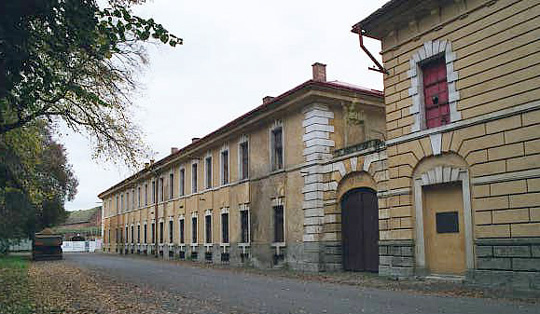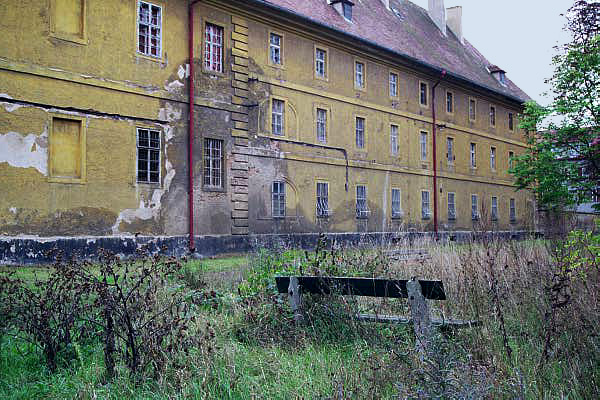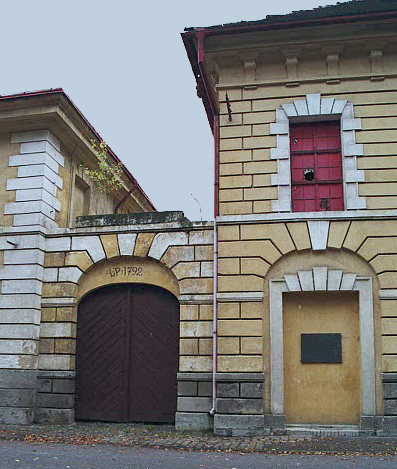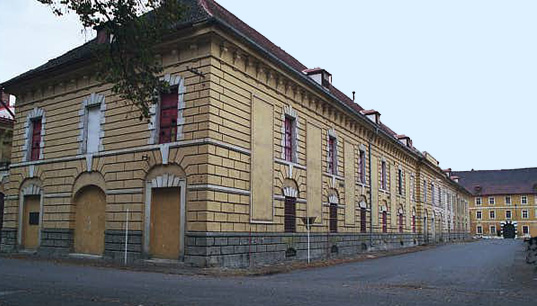Barracks in Theresienstadt ghetto

Bodenbach Barracks,
aka Podmokly barracks
 Far end of Podmokly
barracks building, built in 1792
Far end of Podmokly
barracks building, built in 1792
During World War II, when the Jews of
the Greater German Reich were sent to the former military garrison
in Theresienstadt, they were housed in eleven former barracks
buildings used by the Austrian soldiers in the 18th century.
The photograph above, taken in 2000,
shows the Podmokly barracks, which the Germans called the Bodenbach
barracks; in the background is the bastion on the north side.
There was a metal barrier in front of the bastion, hiding it
from view, and it was off limits to tourists. Inside the bastion
walls was the Aussig barracks which was the "sluice"
where the prisoners were registered when they first arrived.
This building was very primitive with a latrine instead of flush
toilets and rough stone floors.
The Podmokly barrack building is in two
parts, separated by a narrow courtyard. The photo above was taken
from near the end of Langestrasse. On the right, you can see
the edge of Brunnen park. The Podmokly barracks is directly in
line with the Hannover barracks on the opposite side of the garrison
town.
On the left in the photograph above,
you can see the walls of the bastion which juts out from the
garrison on the north side. Directly opposite, on the south side
of the garrison, there is another identical bastion. There were
buildings located between the double walls of each bastion. Inside
the walls of the bastion on the south side was a bakery when
Terezin was the Ghetto Theresienstadt.
Until June 1943, the incoming prisoners
had to walk two miles from the nearest railroad station in the
town of Bohusovice (originally called Bauschowitz by the Germans)
and they entered the ghetto on the same road on which the bus
coming from Prague enters the town today. The railway line from
Bohusovice to the Ghetto ended in front of the Hamburg barracks,
shown in the photo below.
 Hamburg barracks in
Theresienstadt ghetto
Hamburg barracks in
Theresienstadt ghetto
At first, the rules of the ghetto were
extremely strict and incoming prisoners were thoroughly searched
upon arrival. Even the heels of their shoes were searched for
gold or diamonds. Those who tried to bring forbidden objects
inside or send forbidden letters to relatives outside the ghetto
were summarily executed.
On January 10, 1942, 9 prisoners were
hanged by the wall shown on the left in the photograph above.
On February 26, 1942, there were 7 more prisoners hanged in this
location. After that the rules relaxed somewhat. The prisoners
were allowed to send and receive letters and minor offenses were
not so severely punished.
The photograph below shows a doorway
with the date 1792 over the gate into a narrow courtyard between
two sections of the old Podmokly barracks building. Notice the
tree sticking up behind the door. All the old barracks buildings
in the former garrison have inner courtyards and most of the
buildings are a block long. The Podmokly barracks, also called
the Bodenbach barracks, was used to house prisoners and it was
here that the RSHA archives of Berlin were later stored.
 Podmokly barracks were
built in 1792
Podmokly barracks were
built in 1792
The Podmokly building extends the length
of the block between Langestrasse and Hauptstrasse. The photograph
below shows the view of the Podmokly barracks from Postgasse,
on the south side of the barracks, looking towards the entrance
to the Dresden barracks for women, with its entrance on Hauptstrasse.
 Dresden barracks for
women is in the background on the right
Dresden barracks for
women is in the background on the right
 Hannover barracks on
the left, Magdeburg barraks on the right
Hannover barracks on
the left, Magdeburg barraks on the right
|